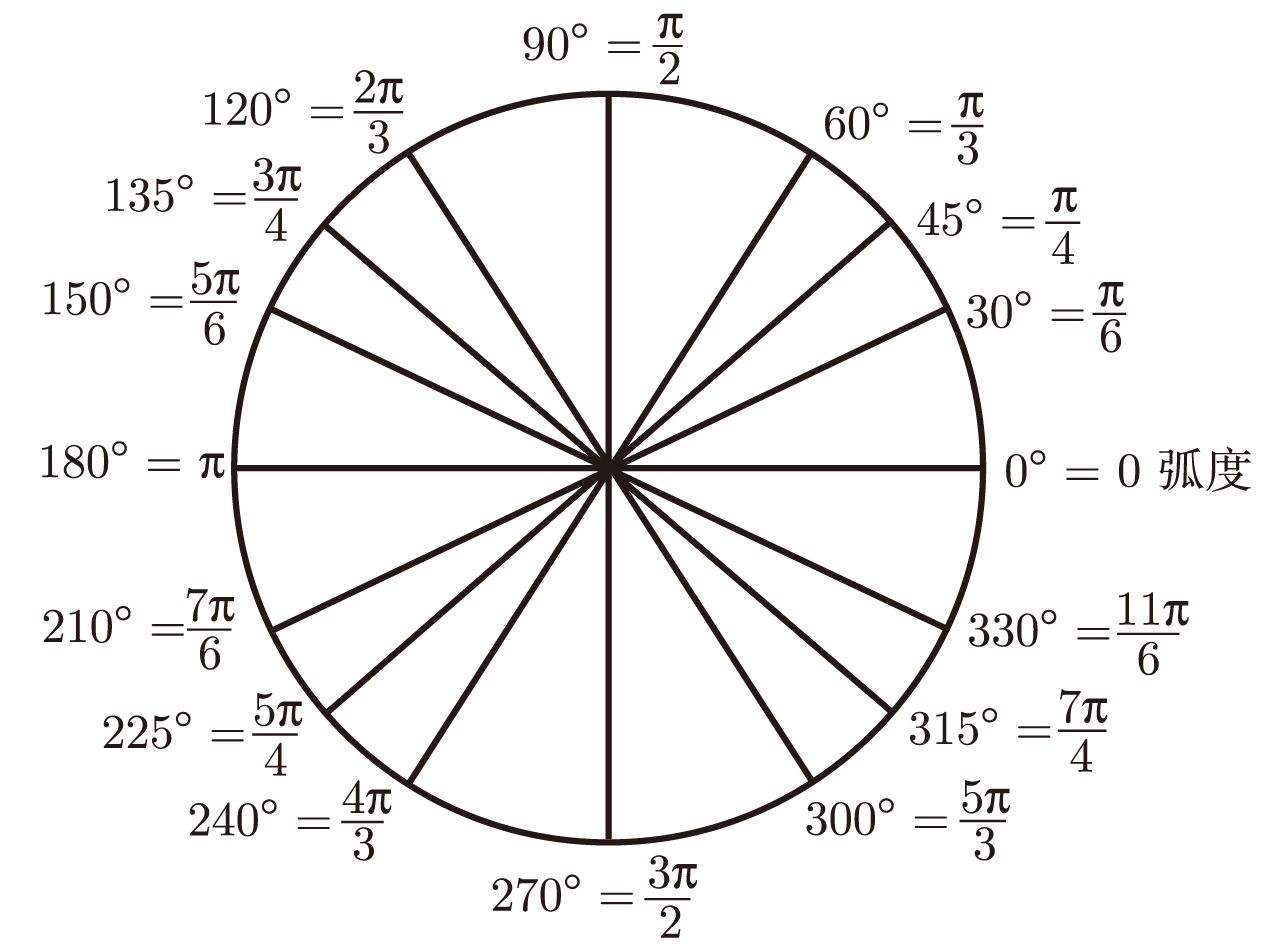Trigonometric Function 三角函数
Definition 基础定义
\[ \sin (\theta) = \frac{y}{r}, \; \cos (\theta) = \frac{x}{r}, \; \tan (\theta) = \frac{y}{x} \\ ~ \\ \csc (\theta) = \frac{r}{y}, \; \sec (\theta) = \frac{r}{x}, \; \cot (\theta) = \frac{x}{y} \]
由此可以得到最基本的关系
Reciprocal 倒数
\[ \sin (\theta) \csc (\theta) = 1 \\ ~ \\ \cos (\theta) \sec (\theta) = 1 \\ ~ \\ \tan (\theta) \cot (\theta) = 1 \]
Quotient 商
\[ \tan (\theta) = \frac{\sin (\theta)}{\cos (\theta)} = \frac{\sec (\theta)}{\csc (\theta)} \\ ~ \\ \cot (\theta) = \frac{\cos (\theta)}{\sin (\theta)} = \frac{\csc (\theta)}{\sec (\theta)} \]
Graph 图像
\[ y = A \sin(Bx - C) + D \text{ or } y = A \cos(Bx - C) + D \\[1em] \begin{aligned} &\text{Amplitude} = |A| \\[0.8em] &\text{Phase Shift} = \frac{C}{B} \\[0.8em] &\text{Period} = \frac{2\pi}{B} \quad \color{blue} \frac{\pi}{B} \text{ for tangent} \\[1.1em] &\text{Vertical Shift} = D \\[0.8em] \end{aligned} \]
Induction Formula 诱导公式
「奇变偶不变,符号看象限」
诱导公式主要目的是将其他象限角规整到第一象限角(超出 \(2\pi\) 的部分通过 \(\frac{n}{2}\) 的方式规整)
对于任意三角函数,都有 \((n\cdot 2\pi \pm \theta) = \theta\)(转一圈,所以我们可以只看余数),所以我们化成另外一种形式 \((\frac{n}{2} \pi \pm \theta )\)
「奇变偶不变」,指后者的 \(n\) 为偶数是保持原有的三角函数不变, \(\sin\) 还是 \(\sin\),\(\cos\) 还是 \(\cos\); 如果是奇数就让原来的三角函数变为其余角所对应的三角函数。
\[ \sin \to \cos \\ \cos \to \sin \\ ~ \\ \tan \to \cot \\ \cot \to \tan \\ ~ \\ \csc \to \sec \\ \sec \to \csc \]
这是因为在 \(n\) (可以看作 \(n\) 就代表的是角度从第 \(n\) 象限开始或结束)为偶数的时候,是以 \(x\) 轴为起始点,而为奇数的时候,是以 \(y\) 轴为起始点,俩者完全对称,并且有余角性质,所以可以通过「奇变偶不变」来总结归纳这样一条规律。
「符号看象限」意思是,\((\frac{n}{2} \pi \pm \theta )\),看作 \(n\) 就代表的是角度从第 \(n\) 象限开始或结束,它所落的象限符号如果是正就不用变,如果是负就加一个负号。涉及到「奇变偶不变」中,「奇变」了之后,就是看变之前所落象限的符号。
以下是所有三角函数象限所对应的符号,其余角所对应三角函数的符号是一致的(只是倒数不影响正负)。
- \(\sin (\theta) = \frac{y}{r}\) 所以 \(y\) 为负时为负
- \(\cos (\theta) = \frac{x}{r}\) 所以 \(x\) 为负时为负
- \(\tan (\theta) = \frac{y}{x}\) 所以 \(x, y\) 单一一个为负的时候为负
- 附

Trigonometric Identities 三角恒等式
Based on the Pythagorean Theorem 基于勾股定理衍生
首先,显而易见的我们知道
\[ a^2 + b^2 = c^2 \]
由此我们可以得到
\[ \sin^{2}(\theta) + \cos^{2}(\theta) = \frac{a^{2}}{c^{2}} + \frac{b^{2}}{c^{2}} = \frac{a^{2}+b^{2}}{c^{2}} = \frac{c^{2}}{c^{2}} = 1 \]
进一步可以得到由此衍生的相关公式,我们将上式除以 \(\cos^{2}(\theta)\) 和 \(\sin^{2}(\theta)\)
\[ \sin^{2}(\theta) + \cos^{2}(\theta) = 1 \implies \frac{\sin^{2}(\theta)}{\cos^{2}(\theta)} + \frac{\cos^{2}(\theta)}{\cos^{2}(\theta)} = \frac{1}{\cos^{2}(\theta)} \implies \tan^{2}(\theta) + 1 = \sec^{2}(\theta) \]
\[ \sin^{2}(\theta) + \cos^{2}(\theta) = 1 \implies \frac{\sin^{2}(\theta)}{\sin^{2}(\theta)} + \frac{\cos^{2}(\theta)}{\sin^{2}(\theta)} = \frac{1}{\sin^{2}(\theta)} \implies 1 + \cot^{2}(\theta) = \csc^{2}(\theta) \]
也可以借助下图记忆,阴影三角形的上面两个相加等于下面的结果
\[ \sin^{2(\theta)} + \cos^{2}(\theta) = 1 \\ ~ \\ \tan^{2}(\theta) + 1 = \sec^{2}(\theta) \\ ~ \\ 1 + \cot^{2}(\theta) = \csc^{2}(\theta) \]
Plus and Minus 和差
\[ \sin(\alpha \pm \beta) = \sin(\alpha)\cos(\beta) \pm \cos(\alpha)\sin(\beta) \\[0.6em] \cos(\alpha \pm \beta) = \cos(\alpha)\cos(\beta) \pm \sin(\alpha)\sin(\beta) \\[0.8em] \tan(\alpha \pm \beta) = \frac{\tan(\alpha) \pm \tan(\beta)}{1 \mp \tan(\alpha)\tan(\beta)} \]
Double Angle 倍角
通过欧拉公式
\[ \begin{aligned} e^{i \theta} &= \cos (\theta) + i \sin (\theta) \\[0.3em] e^{i 2\theta} &= \cos (2\theta) + i \sin (2\theta) \\[0.3em] e^{i \theta}\cdot e^{i \theta} &= (\cos (\theta) + i \sin (\theta))(\cos (\theta) + i \sin (\theta)) \\[0.3em] \cos (2\theta) + i \sin (2\theta) &= \cos^{2} (\theta) - \sin^{2} (\theta) + 2 \cos (\theta) \sin (\theta) i \end{aligned} \]
\[ \downarrow \]
\[ \cos (2\theta) = \cos^{2} (\theta) - \sin^{2} (\theta) \\ \sin (2\theta) = 2 \cos (\theta) \sin (\theta) \]
\[ \downarrow \]
\[ (\sin(\theta) + \cos(\theta))^{2} = \sin^{2} (\theta) + \cos^{2} (\theta) + 2\sin(\theta) \cos (\theta) = 1 + \sin (2\theta) \]
- 例题
\(\text{(a)}\)
\[ \int_{0}^{2 \pi} \sin(\theta) \cos(\theta) ~\mathrm{d}\theta \]
思路 \(\text{(i)}\) 三角恒等式
\[ \begin{aligned} \int_{0}^{2 \pi} \sin(\theta) \cos(\theta) ~\mathrm{d}\theta &= \frac{1}{2} \int_{0}^{2 \pi} \sin(2\theta) ~\mathrm{d}\theta \\[0.8em] &= \frac{1}{4} \int_{0}^{2\pi} \sin(u) ~\mathrm{d}u \quad \color{blue} \text{apply u-sub } \mathrm{d}\theta = \frac{1}{2} \mathrm{d}u \\[0.8em] &= \frac{1}{4} \cdot -\cos(2x)\bigg|_{0}^{2\pi} = - \frac{1}{4} + \frac{1}{4} = 0 \end{aligned} \]
思路 \(\text{(ii)}\) 分部积分
选取如下 \(u, v\)
\[ \def\arraystretch{1.5} \begin{array} { c | c | c} & u & v \\ \hline \text{No-d} & \sin(\theta) & \sin(\theta) \\ \hline \text{D} & \cos(\theta) & \cos(\theta) \end{array} \]
\[ \begin{aligned} uv &= \int u\cdot \mathrm{d}v + \int v\cdot \mathrm{d}u \\[0.8em] uv \bigg|_{0}^{2\pi} &= \int_{0}^{2 \pi} \sin(\theta) \cos(\theta) ~\mathrm{d}\theta + \int_{0}^{2 \pi} \sin(\theta) \cos(\theta) ~\mathrm{d}\theta \\[0.8em] \frac{\sin(\theta)\cos(\theta)}{2} \bigg|_{0}^{2 \pi} &= \int_{0}^{2 \pi} \sin(\theta) \cos(\theta) ~\mathrm{d}\theta = 0 \end{aligned} \]
\[ \tan(2 \theta) = \frac{2 \tan(\theta)}{1 - \tan^{2}(\theta)} \]
Descending Power 降幂
首先通过勾股定理衍生
\[ \sin^{2} (\theta)+ \cos^{2} (\theta) = 1 \implies \begin{cases} \sin^{2} (\theta) = 1 - \cos^{2} (\theta) \\ \cos^{2} (\theta) = 1 - \sin^{2} (\theta) \end{cases} \]
我们知道 \(\cos\) 的倍角公式
\[ \cos (2\theta) = \cos^{2} (\theta) - \sin^{2} (\theta) \\ \]
将 \(\sin^{2} (\theta) = 1 - \cos^{2} (\theta)\) 或 \(\cos^{2} (\theta) = 1 - \sin^{2} (\theta)\) 带入
\[ \begin{cases} \cos (2\theta) = (1 - \sin^{2} (\theta)) - \sin^{2} (\theta) \\ \cos (2\theta) = \cos^{2} (\theta)- (1 - \cos^{2} (\theta)) \end{cases} \]
\[ \downarrow \]
\[ \begin{cases} \sin^{2} (\theta) = \frac{1}{2}(1 - \cos 2\theta) \\ \cos^{2} (\theta) = \frac{1}{2}(1 + \cos 2\theta) \end{cases} \]
\(\text{(a)}\)
\[ \int_{0}^{2\pi} \sin^{2}(\theta) ~\mathrm{d}\theta \]
思路 \(\text{(i)}\) 三角恒等式
\[ \begin{aligned} \int_{0}^{2\pi} \sin^{2}(\theta) ~\mathrm{d}\theta &= \frac{1}{2} \int_{0}^{2\pi} 1 - \cos (2 \theta) ~\mathrm{d}\theta \\[0.8em] &= \frac{1}{2} \int_{0}^{2 \pi} 1 ~\mathrm{d}\theta - \frac{1}{2}\int_{0}^{2 \pi} \cos (u) ~\mathrm{d}u \quad \color{blue} \text{apply u-sub } \mathrm{d}\theta = \frac{1}{2} \mathrm{d}u \\[0.8em] &= \frac{1}{2} (\theta \bigg|_{0}^{2\pi} - \sin (\theta) \bigg|_{0}^{2\pi} ) \\[0.8em] &= \pi \end{aligned} \]
思路 \(\text{(ii)}\) 分部积分
选取如下 \(u, v\)
\[ \def\arraystretch{1.5} \begin{array} { c | c | c} & u & v \\ \hline \text{No-d} & \sin(\theta) & -\cos(\theta) \\ \hline \text{D} & \cos(\theta) & \sin(\theta) \end{array} \]
\[ \begin{aligned} uv &= \int u\cdot \mathrm{d}v + \int v\cdot \mathrm{d}u \\[0.8em] uv \bigg|_{0}^{2\pi} &= \int_{0}^{2 \pi} \sin^{2}(\theta) ~\mathrm{d}\theta - \int_{0}^{2 \pi} \cos^{2}(\theta) ~\mathrm{d}\theta \\[0.8em] uv \bigg|_{0}^{2\pi} &= \int_{0}^{2 \pi} \sin^{2}(\theta) ~\mathrm{d}\theta - \int_{0}^{2 \pi} 1 - \sin^{2}(\theta) ~\mathrm{d}\theta\\[0.8em] uv + \int_{0}^{2 \pi} 1 ~\mathrm{d}\theta &= 2 \int_{0}^{2 \pi} \sin^{2}(\theta) ~\mathrm{d}\theta\\[0.8em] \frac{-\sin(\theta)\cos(\theta) + \theta \bigg|_{0}^{2 \pi} }{2} \bigg|_{0}^{2 \pi} &= \int_{0}^{2 \pi} \sin^{2}(\theta) ~\mathrm{d}\theta = \pi \end{aligned} \]
\[ \tan^{2}(\theta) = \frac{1-\cos^{2}(\theta)}{1 + \cos^{2}(\theta)} \]
Auxiliary Angle 辅助角公式
对于任意 \(\sin (\theta), \cos (\theta), \tan (\theta)\) 都能写成非三角函数的勾股定理形式
\[ \cos (\varphi) = \frac{a}{\sqrt{a^{2} + b^{2}}}, \; \sin (\varphi) = \frac{b}{\sqrt{a^{2} + b^{2}}}, \; \tan (\varphi) = \frac{\sin (\varphi)}{\cos (\varphi)} = \frac{b}{a} \]
所以我们可以对 \(y = a \sin(x) + b \cos(x)\) 整理
Note: \(\cos(\theta - \frac{\pi}{2}) = \sin(\theta)\)
\[ \begin{aligned} y &= a \sin x + b \cos x \\[0.3em] &= \sqrt{a^{2} + b^{2}} \left( \sin (x) \cdot \frac{a}{\sqrt{a^{2} + b^{2}}} + \cos (x) \cdot \frac{b}{\sqrt{a^{2} + b^{2}}} \right) \\[1em] &= \sqrt{a^{2} + b^{2}} \left( \sin (x) \cos (\varphi) + \cos (x) \sin (\varphi) \right) \\[0.8em] &= \sqrt{a^{2} + b^{2}} \sin (x + \varphi) \\[0.8em] &= \sqrt{a^{2} + b^{2}} \cos (x + \varphi - \frac{\pi}{2}) \end{aligned} \]
- 例题
\(\text{(1)}\)
\[ \begin{aligned} y &= \sqrt{3} \sin (2x) + \cos (2x) \\[0.6em] &= \sqrt{3} \sin (2x) + 1\cdot \cos (2x) \\[0.8em] &= \sqrt{(\sqrt{3})^{2} + 1^{2}} \cdot \sin(2x + \varphi) \\[1em] &= 2 \sin(2x + \varphi) \end{aligned} \]
所以我们可以确定 \(a = \sqrt{3}, \; b = 1\)
\[ \tan (\varphi) = \frac{b}{a} = \frac{1}{\sqrt{3}} = \frac{\sqrt{3}}{3} = \tan\left(\frac{\pi}{6}\right) \\[0.6em] \varphi = \frac{\pi}{6} \]
Half Angle 半角
\[ \sin \left( \frac{\theta}{2} \right) = \pm \sqrt{\frac{1-\cos(\theta)}{2}} \\[1em] \cos \left( \frac{\theta}{2} \right) = \pm \sqrt{\frac{1+\cos(\theta)}{2}} \\[1em] \tan \left( \frac{\theta}{2} \right) = \pm \sqrt{\frac{1-\cos(\theta)}{1 + \cos(\theta)}} \]
Note: \(\tan\left( \frac{\pi}{2} \right), \; \frac{a}{\sin(2k \pi)}\) don’t exist.
- Identity (\(\theta \neq \pi + 2k \pi\))
\[ \tan \left( \frac{\theta}{2} \right) = \frac{\sin \left( \frac{\theta}{2} \right)}{\cos \left( \frac{\theta}{2} \right)} = \frac{2 \sin\left( \frac{\theta}{2} \right) \cos\left( \frac{\theta}{2} \right) }{2 \cos^{2}(\frac{\theta}{2})} = \frac{\sin(\theta)}{1 + \cos(\theta)} \]
- Nonidentity (Left: \(\theta \neq \pi + 2k \pi\), Right: \(\theta \neq 2k \pi\))
\[ \tan \left( \frac{\theta}{2} \right) = \frac{\sin \left( \frac{\theta}{2} \right)}{\cos \left( \frac{\theta}{2} \right)} = \frac{2 \sin^{2}\left( \frac{\theta}{2} \right)}{2 \sin\left(\frac{\theta}{2}\right)\cos\left( \frac{\theta}{2} \right) } = \frac{1 - \cos(\theta)}{\sin (\theta)} \]
Sum to Product 和差化积
\[ \sin(\alpha) \pm \sin(\beta) = 2 \sin \left( \frac{\alpha \pm \beta}{2} \right) \cos \left( \frac{\alpha \mp \beta}{2} \right) \\[1em] \cos(\alpha) + \cos(\alpha) = 2 \cos \left( \frac{\alpha + \beta}{2} \right) \cos\left( \frac{\alpha - \beta}{2} \right) \\[1em] \cos(\alpha) - \cos(\alpha) = - 2 \sin \left( \frac{\alpha + \beta}{2} \right) \sin\left( \frac{\alpha - \beta}{2} \right) \]
Product to Sum 积化和差
\[ \sin(\alpha) \cos(\beta) = \frac{1}{2} \left[ \sin(\alpha + \beta) + \sin(\alpha - \beta) \right] \\[0.8em] \cos(\alpha) \sin(\beta) = \frac{1}{2} \left[ \sin(\alpha + \beta) - \sin(\alpha - \beta) \right] \\[0.8em] \cos(\alpha) \cos(\beta) = \frac{1}{2} \left[ \cos(\alpha + \beta) + \cos(\alpha - \beta) \right] \\[0.8em] \sin(\alpha) \sin(\beta) = -\frac{1}{2} \left[ \cos(\alpha + \beta) - \cos(\alpha - \beta) \right] \]
Trigonometric Equation 三角方程
- 对于 \(\sin(x) = a\),我们可以进行如下讨论
\(\text{(1) } a = 1\) 时 \(x \in \left\{x | x = 2k \pi + \frac{\pi}{2}, k \in \mathbb{Z}\right\}\)
\(\text{(2) } a = -1\) 时 \(x \in \left\{x | x = 2k \pi - \frac{\pi}{2}, k \in \mathbb{Z}\right\}\)
\(\text{(3) } |a| < 1\) 时 \(x \in \left\{x | x = k \pi + (-1)^{k} \arcsin(a), k \in \mathbb{Z}\right\}\)
\(\text{(4) } |a| > 1\) 时 \(x \in \varnothing\)
- 对于 \(\cos(x) = a\),我们可以进行如下讨论
\(\text{(1) } a = 1\) 时 \(x \in \left\{x | x = 2k \pi, k \in \mathbb{Z}\right\}\)
\(\text{(2) } a = -1\) 时 \(x \in \left\{x | x = 2k \pi + \pi, k \in \mathbb{Z}\right\}\)
\(\text{(3) } |a| < 1\) 时 \(x \in \left\{x | x = 2k \pi \pm \arccos(a), k \in \mathbb{Z}\right\}\)
\(\text{(4) } |a| > 1\) 时 \(x \in \varnothing\)
对于 \(\tan(x) = a\),\(x \in \left\{x | x = k \pi + \arctan(a), k \in \mathbb{Z}\right\}\)
反三角
\[ \arcsin(-x) = -\arcsin(x) \\ \arccos(-x) = \pi - \arccos(x) \\ \arctan(-x) = -\arctan(x) \]
余/正弦定理
若存在 \(\triangle ABC\),其外接圆半径为 \(R\)
\[ \frac{a}{\sin(\angle A)} = \frac{b}{\sin(\angle B)} = \frac{c}{\sin (\angle C)} = 2R \\[1em] a^{2} = b^{2} + c^{2} - 2bc\cdot \cos(\alpha) \\[1em] b^{2} = a^{2} + c^{2} - 2ac\cdot \cos(\beta) \\[1em] c^{2} = a^{2} + b^{2} - 2ab\cdot \cos(\gamma) \]
Differentiated 求导
\[ \begin{aligned} (\sin(\theta))' &= \cos(\theta) \\ (\cos(\theta))' &= -\sin(\theta) \\ (\tan(\theta))' &= \sec^{2}(\theta) \\ (\cot(\theta))' &= -\csc^{2}(\theta) \\ (\sec(\theta))' &= \tan(\theta)\sec(\theta) \\ (\csc(\theta))' &= - \cot(\theta)\csc(\theta) \\ (\arcsin(\theta))' &= \frac{1}{\sqrt{1 - x^{2}}} \\ (\arctan(\theta))' &= \frac{1}{1+x^{2}} \end{aligned} \]
Integral 积分
\[ \begin{aligned} \int \sin(\theta) ~\mathrm{d}\theta &= - \cos(\theta) + C \\[0.8em] \int \cos(\theta) ~\mathrm{d}\theta &= \sin(\theta) + C \\[0.8em] \int \tan(\theta) ~\mathrm{d}\theta &= - \ln| \cos(\theta) | + C \\[0.8em] \int \cot(\theta) ~\mathrm{d}\theta &= \ln| \sin(\theta) | + C \\[0.8em] \int \sec(\theta) ~\mathrm{d}\theta &= \ln| \tan(\theta) + \sec(\theta) | + C \\[0.8em] \int \csc(\theta) ~\mathrm{d}\theta &= \ln| \csc(\theta) - \cot(\theta) | + C \\ \end{aligned} \]
To be continued…
